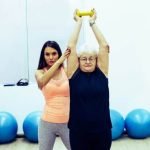Regular exercise is crucial for maintaining overall health and fitness, but not all workouts are created equal. Low impact full body exercise and fitness offer a gentle yet effective way to stay in shape without putting excessive strain on the body.
In this article, we will explore the concept of low impact exercises and the numerous benefits they bring. From preventing injuries to improving cardiovascular health, incorporating low impact full body workouts into your routine can have transformative effects on both your physical and mental well-being.
Low impact exercises refer to activities that minimize stress on the joints and muscles while still providing a complete workout for the entire body. Unlike high impact workouts that involve jumping or running, low impact exercises prioritize fluid movements that are easier on the body. This makes them suitable for individuals of all ages and fitness levels, including those who may have joint issues or physical limitations.
Engaging in full body workouts through low impact exercises offers several advantages for overall fitness. These workouts target multiple muscle groups simultaneously, effectively toning and strengthening the entire body. Additionally, by incorporating various low impact exercises into your routine, you can improve flexibility, balance, and coordination. The versatility of low impact exercise options ensures there is something for everyone’s preferences and goals.
In the following sections of this article, we will delve deeper into understanding low impact exercise and why it matters. We will also explore the best low impact exercises for a full body workout, provide tips for designing your own fitness routine, discuss case studies of successful transformations, address safety precautions, and highlight how these exercises benefit individuals as they age.
By embracing the power of low impact full body exercise and fitness, you can enjoy a healthier, fitter lifestyle that suits your unique needs and goals.
Understanding Low Impact Exercise
When it comes to exercise, it’s essential to understand the differences between low impact and high impact workouts. Low impact exercise refers to activities that put minimal stress on your joints, making them ideal for individuals of all fitness levels and ages. Unlike high impact exercises that involve jumping or sudden movements, low impact exercises maintain at least one foot in contact with the ground at all times.
One of the primary reasons why low impact exercise matters is its ability to prevent joint and muscle injuries. By choosing low impact workouts, you can minimize the strain on your joints while still reaping the benefits of physical activity. This makes low impact exercises an excellent option for individuals who are recovering from an injury or have conditions such as arthritis or joint pain.
The importance of low impact exercise goes beyond injury prevention. These types of workouts also allow you to build cardiovascular endurance without subjecting your body to excessive stress. By engaging in activities like walking, swimming, or cycling, you can improve your heart health and increase your overall fitness level without placing unnecessary strain on your body.
Exploring the Best Low Impact Exercises for a Full Body Workout
Swimming
One of the best low impact exercises for a full body workout is swimming. Not only does swimming engage multiple muscle groups, but it also provides a cardiovascular workout that strengthens the heart and lungs. Swimming is considered a low impact exercise because the buoyancy of the water helps to support the body’s weight, reducing stress on the joints.
Additionally, swimming offers resistance as you move through the water, which helps to build strength and endurance. Whether you choose to swim laps or participate in water aerobics classes, swimming is an excellent choice for a full body workout.
Yoga
Yoga is another fantastic low impact exercise that can provide a full body workout. With its focus on flexibility, balance, and strength, yoga helps to improve posture and increase overall muscle tone. Practicing yoga poses also promotes relaxation and stress reduction through controlled breathing techniques.
Yoga can be tailored to fit different fitness levels and abilities, making it accessible to everyone. From gentle Hatha Yoga to more physically demanding Vinyasa or Power Yoga classes, there are various styles of yoga available for individuals looking to engage in a low impact full body workout.
Cycling
Cycling is an excellent low impact exercise option that targets both the lower and upper body muscles while providing cardiovascular benefits. Whether outdoors on a bicycle or indoors on a stationary bike, cycling allows individuals to control their speed and resistance levels based on their fitness level and goals. This makes cycling suitable for beginners as well as those looking for more challenging workouts.
Cycling helps strengthen leg muscles such as quadriceps, hamstrings, glutes while also engaging core muscles such as abdominals and back muscles. It is an effective way to burn calories while being gentle on joints.
By incorporating swimming, yoga, pilates, or cycling into your fitness routine, you can enjoy the benefits of low impact exercises while achieving a full body workout. These exercises allow individuals to engage multiple muscle groups without placing excessive stress on joints and muscles, making them ideal for individuals with limitations or injuries.
Additionally, these low impact exercises offer various benefits beyond fitness, such as improved cardiovascular health, increased flexibility and balance, reduced stress levels, and enhanced mental well-being. So whether you are a beginner or someone looking to switch up your exercise routine, consider incorporating these low impact exercises for a full body workout that will keep you fit and healthy.
Designing Your Low Impact Fitness Routine
When it comes to designing a low impact fitness routine, it’s important to create a plan that takes into account your individual needs and goals. Here are some tips and tricks to help you design an effective low impact full body workout plan:
- Start with a Warm-Up: Before diving into your low impact exercises, it’s essential to warm up your muscles and joints. This can be done through light cardio exercises such as brisk walking or jumping jacks. A warm-up increases blood flow to the muscles, reduces the risk of injury, and prepares your body for the workout ahead.
- Incorporate Variety: To ensure you target all muscle groups in your body, it’s important to include a variety of low impact exercises in your routine. This helps prevent muscle imbalance and keeps the workout interesting. Consider including exercises like swimming, yoga, pilates, cycling, or strength training using resistance bands or lightweight dumbbells.
- Balance Cardiovascular Exercise with Strength Training: While low impact exercises are often associated with cardiovascular workouts, it’s crucial to incorporate strength training into your routine as well. Strength training exercises like squats, lunges, push-ups, and planks help build muscle mass and improve overall body strength. Aim for at least two days of strength training per week.
- Gradually Increase Intensity: As you become more comfortable with your low impact fitness routine, don’t be afraid to gradually increase the intensity of your workouts. This can be done by adding more repetitions or sets to each exercise or by incorporating harder variations of certain moves.
- Listen to Your Body: One of the advantages of low impact exercises is that they are gentle on the joints and muscles. However, it’s still important to listen to your body and modify any movements that cause pain or discomfort. If needed, consult with a fitness professional who can help tailor the routine to your specific needs.
Remember, a well-designed low impact fitness routine should address all areas of your body while keeping you motivated and injury-free. By following these tips and tricks, you can create a personalized workout plan that helps you achieve your fitness goals while prioritizing the health and safety of your body.
The Physical and Mental Health Benefits of Low Impact Full Body Exercise
Regular exercise is not only important for maintaining physical fitness but also has numerous benefits for mental well-being. Low impact full body exercises, in particular, offer a wide range of physical and mental health advantages. These exercises are designed to minimize stress on the joints while engaging multiple muscle groups, providing a comprehensive workout without the risk of injury.
One of the key benefits of low impact full body exercise is its positive impact on cardiovascular health. Engaging in activities such as swimming or cycling can improve heart and lung function, reduce the risk of heart disease, and lower blood pressure. These exercises also help with weight management by burning calories and increasing metabolism. Incorporating low impact exercises into a fitness routine can contribute to overall improvements in cardiovascular health, promoting a longer and healthier lifespan.
In addition to the physical benefits, low impact full body exercise also plays a significant role in mental well-being. Regular exercise releases endorphins, which are feel-good hormones that elevate mood and reduce stress levels. Low impact workouts like yoga and pilates incorporate mindfulness and relaxation techniques that further enhance their positive effects on mental health. Engaging in these activities helps reduce symptoms of anxiety and depression while improving sleep quality and cognitive function.
By embracing low impact full body exercise, individuals can experience both physical and mental transformations. The inclusivity of these exercises makes them suitable for people of all fitness levels, from beginners to athletes recovering from injuries or looking for alternative workout options. With countless options available such as swimming, yoga, pilates, and cycling, individuals have the flexibility to choose activities that align with their preferences and fitness goals.
To fully reap the benefits of low impact full body exercise, it is essential to incorporate it into a regular fitness routine. By making it a habit, individuals can improve their overall health while enjoying the positive effects on both mind and body. Whether one seeks cardiovascular strength or mental peace, low impact full body exercise offers a holistic approach that promotes a healthy and fulfilling lifestyle.
Low Impact Exercise and Aging
The Benefits of Low Impact Exercise for Aging Individuals
As individuals age, it becomes increasingly important to prioritize fitness and exercise in order to maintain overall health and well-being. However, many older adults may have physical limitations or concerns about their ability to engage in certain types of exercise. This is where low impact exercises can play a crucial role in ensuring that aging individuals can stay fit and active without putting undue strain on their bodies.
One key benefit of low impact exercise for aging individuals is the reduced risk of injury and joint strain. High impact exercises, such as running or jumping, can often place excessive stress on joints, leading to discomfort or potential injury. In contrast, low impact exercises are gentle on the joints and muscles, making them an ideal choice for older adults who may have age-related joint issues or conditions such as arthritis.
Additionally, low impact exercises provide an effective way for aging individuals to improve cardiovascular health without subjecting themselves to overly strenuous activities. Activities like swimming, cycling, and brisk walking can increase heart rate and promote circulation while minimizing the risk of strain or injury. Regular low impact exercise has been shown to lower the risk of chronic diseases such as heart disease, diabetes, and high blood pressure, helping older adults maintain optimal health.
Incorporating Low Impact Exercises into a Fitness Routine for Aging Individuals
When designing a fitness routine for aging individuals that focuses on low impact exercises, it is essential to consider their unique needs and limitations. Here are some guidelines to ensure a safe and effective workout:
- Begin with a warm-up: Prioritize warming up the body before engaging in any activity. Gentle movements such as arm circles or leg swings can help increase blood flow to the muscles and prepare them for exercise.
- Choose a variety of exercises: Incorporate a mix of cardiovascular activities like swimming or stationary biking with strength training exercises that target all major muscle groups. This combination supports overall fitness and helps maintain bone density.
- Monitor intensity levels: Older adults should aim for a moderate level of intensity during their workouts. Being able to carry on a conversation comfortably during exercise is a good indicator that the intensity is appropriate.
- Focus on flexibility and balance: Aging individuals may experience a decrease in flexibility and balance, which can increase the risk of falls and injuries. Including exercises like yoga or tai chi can help improve flexibility and stability while reducing the risk of accidents.
- Listen to the body: It’s important for aging individuals to pay attention to any discomfort or pain during exercise. If something feels off, they should modify the exercise or consult with a healthcare professional to ensure they are engaging in activities appropriate for their fitness level.
By following these guidelines and incorporating low impact exercises into their routine, aging individuals can enjoy the numerous benefits of regular physical activity while minimizing strain on their bodies. Fitness knows no age limits, and low impact exercises provide a safe and accessible way for aging individuals to stay fit and active throughout their lives.
Safety First
Low impact exercise is a wonderful way to stay fit and active without putting excessive stress on your joints and muscles. However, it is crucial to prioritize safety and proper form during these workouts to avoid potential injuries. In this section, we will discuss the importance of taking precautions and maintaining correct posture when engaging in low impact full body exercises.
Safety should always be the top priority when participating in any physical activity. When it comes to low impact full body exercise, there are several precautions you can take to ensure a safe workout experience. First and foremost, it is essential to listen to your body and recognize its limitations. If an exercise feels painful or uncomfortable, modify or stop doing it immediately.
Another important aspect of safety during low impact exercise is maintaining proper posture. Correct posture not only maximizes the effectiveness of the exercise but also reduces the risk of injury. For example, when performing exercises that involve bending or lifting, such as squats or deadlifts, make sure to keep your back straight and engage your core muscles for stability.
Using appropriate equipment is also crucial for safety during low impact full body workouts. Whether you are using resistance bands, yoga mats, or cycling equipment, make sure they are in good condition and suitable for your needs. Additionally, remember to warm up before each session and cool down afterward to prevent muscle strain.
By following these precautions and maintaining proper form during low impact full body exercises, you can minimize the risk of injuries while reaping the benefits of a healthier lifestyle.
| Precautions for Low Impact Full Body Exercise | Tips for Maintaining Proper Form |
|---|---|
| Listen to your body and modify or stop exercises that cause pain or discomfort | Keep your back straight and engage core muscles for stability during bending or lifting movements |
| Use appropriate equipment that is in good condition | Warm up before and cool down after each workout session to prevent muscle strain |
| Avoid overexertion and gradually increase the intensity of your workouts | Focus on maintaining proper alignment of your joints during exercises such as lunges or step-ups |
Case Studies
As the popularity of low impact full body exercise continues to rise, many individuals have experienced transformative results through these workouts. In this section, we will explore inspiring case studies of people who have achieved significant fitness goals by embracing low impact exercise. These success stories demonstrate the effectiveness and accessibility of this type of workout for individuals from diverse backgrounds and fitness levels.
One success story is the journey of Sarah, a 45-year-old woman who struggled with joint pain and arthritis. After consulting with her doctor, she decided to incorporate low impact exercises into her fitness routine to minimize strain on her joints. Sarah started attending yoga and pilates classes regularly, focusing on gentle movements that improved flexibility, strength, and balance.
Over time, she noticed a reduction in joint pain and an increase in overall mobility. Not only did Sarah achieve a greater range of motion, but she also experienced weight loss and an improvement in her mental well-being.
Another success story comes from Mark, a middle-aged man who wanted to improve his cardiovascular health without putting excessive stress on his body. He discovered the benefits of swimming as a low impact full body exercise that provided a complete workout while being easy on his joints.
With consistent swimming sessions at his local pool, Mark saw an improvement in his heart health as his endurance increased significantly. Additionally, he noticed improvements in his muscle tone and overall stamina.
These case studies highlight just two examples of how low impact full body exercise can lead to transformative results for individuals seeking to improve their fitness levels without risking injury or strain. By choosing exercises that prioritize joint protection and focusing on gentle movements that engage multiple muscle groups simultaneously, individuals can achieve their desired goals while minimizing physical stress on their bodies.
| Name | Age | Exercise | Result |
|---|---|---|---|
| Sarah | 45 | Yoga and pilates | – Reduced joint pain – Improved mobility and flexibility. – Weight loss. – Improved mental well-being |
| Mark | 50 | Swimming | – Improved cardiovascular health – Increased endurance. – Improved muscle tone and stamina |
Conclusion
In conclusion, low impact full body exercise and fitness offer numerous benefits for individuals of all fitness levels. By embracing these types of workouts, individuals can improve their overall fitness, while also preventing joint and muscle injuries. The physical and mental health benefits of low impact exercises are substantial, including improved cardiovascular health, weight management, stress reduction, and enhanced mental well-being.
One of the key advantages of low impact full body exercise is its inclusivity. These workouts are suitable for individuals of all ages and physical abilities, making it an ideal option for older adults or those with physical limitations. With a wide range of low impact exercises to choose from, including swimming, yoga, pilates, and cycling, individuals can tailor their fitness routine to target specific muscle groups while maintaining a low impact on the joints.
To incorporate low impact full body exercises into a fitness routine effectively, it is important to balance different exercises and include strength training. This ensures that every major muscle group is engaged and developed evenly. Additionally, proper form and posture are crucial to avoid injuries during these workouts. Individuals should take precautions by modifying exercises as needed and using appropriate equipment for added safety.
Overall, embracing the power of low impact full body exercise and fitness can lead to a healthier and fitter lifestyle. By integrating these exercises into their routine, individuals can experience positive transformations in their physical health while enjoying the mental benefits that come with regular exercise. It is never too late to start incorporating low impact workouts into one’s routine and reap the many rewards they offer for overall well-being.

Passionate about providing useful information to anyone with an interest in the field of Personal Training, I strive to pass on to our readers quality information and to answer any questions about Personal Trainers, the work they do and how to become one.





